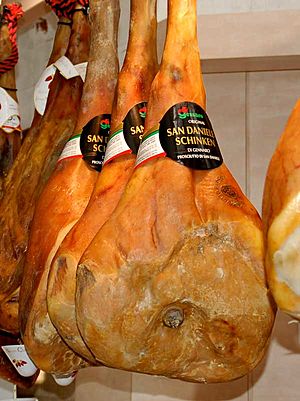Italian Sounding facts for kids
Italian Sounding is a term for products that look or sound Italian but are not actually from Italy. This often involves using Italian words, images, or even the colours of the Italian flag (green, white, and red). These products are sold as if they are Italian, but they have no real connection to Italian cuisine.
This marketing trick causes a lot of harm to the real Italian economy. It makes people think they are buying genuine "Made in Italy" food, but they are not. In fact, about two out of three Italian food products sold around the world are actually fakes. This "Italian Sounding" problem costs Italy about €55 billion every year.
Contents
Why do fake Italian products exist?
How Italian migration led to "Italian Sounding"
The idea of "Italian Sounding" started a long time ago. Many Italians moved to other countries, especially North and South America, in the late 1800s and early 1900s. They took their traditions and recipes with them.
Over time, these recipes changed to fit the new countries. This was often because certain ingredients were hard to find.
The global spread of Italian food culture
Thanks to globalization, more and more people around the world love Italian culture and food. This has created a huge demand for Italian products. However, many people don't know what real Italian products are like.
Sometimes, it's also hard to find true Italian food in some places. This gives companies a chance to sell products that seem Italian, even if they are not. They use Italian-sounding names or designs to trick buyers.
Fighting against fake Italian products
Government efforts to protect "Made in Italy"
The Italian government and other groups are working hard to stop "Italian Sounding" products. The Italian Trade Agency and the Italian Ministry of Foreign Affairs have worked together in countries like the United States, Canada, and Russia. These are places where real Italian products are very popular.
One example is the "Task Force Canada" project from 2011 to 2012. This project helped show how to fight against fake products. Italy's Ministry of Economic Development (MISE) and the Italian Customs Agency also train young people about this problem.
Italian police and companies join the fight
Different police forces in Italy, like the Polizia di Stato and the Guardia di Finanza, are also involved. They focus on companies that import cheap ingredients from other countries. These companies then turn the ingredients into products and sell them as Italian. This practice harms real Italian businesses.
Many private companies are also helping. For example, one startup created a app. You can scan a product's barcode with the app. It tells you if the product is truly "Made in Italy" or not. If it's fake, you can report it.
In 2021, a person in the United States started a social media movement called "Stop Italian Sounding." This movement uses educational videos to teach people about the issue.
Most commonly faked Italian foods
Many Italian food products are copied around the world. Here are some of the most common ones:
- Parmigiano Reggiano (a type of hard cheese)
- Mozzarella di bufala (a soft, fresh cheese)
- Prosecco (a sparkling wine)
- Pecorino (a hard cheese made from sheep's milk)
- Gorgonzola (a blue cheese)
- Grana Padano (another hard cheese, similar to Parmigiano)
- Prosciutto di San Daniele (a type of cured ham)
- Asiago (a cheese from northern Italy)
- Chianti (a red wine)
- Salame (a type of cured sausage)





